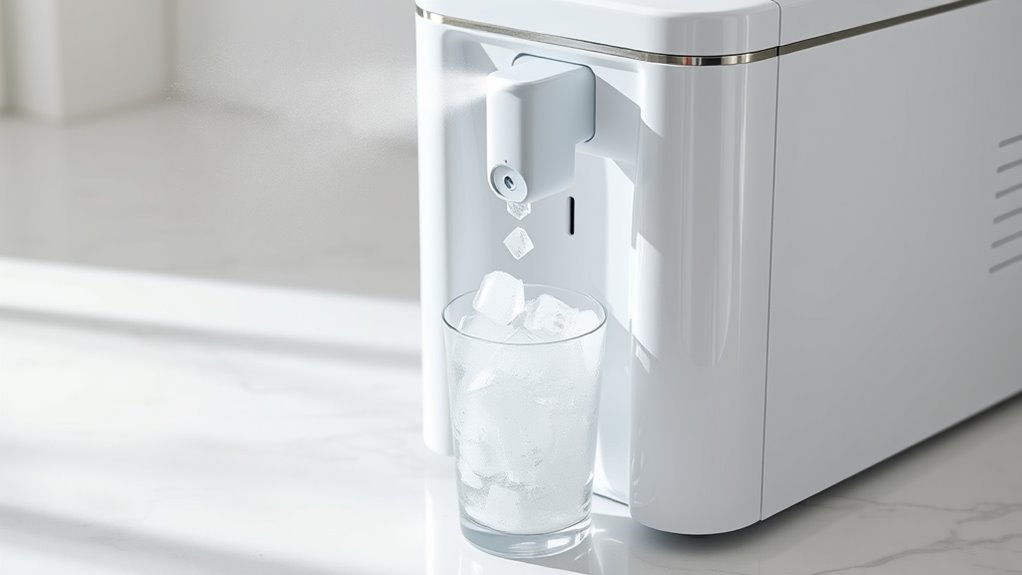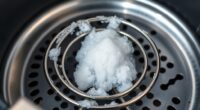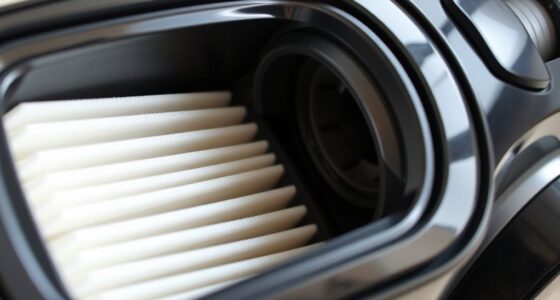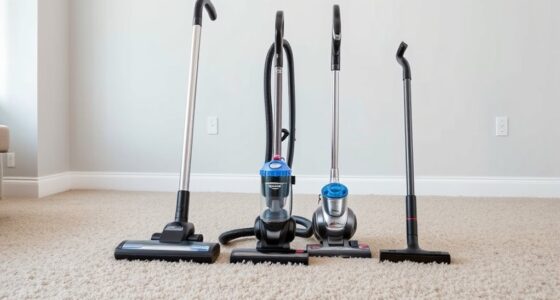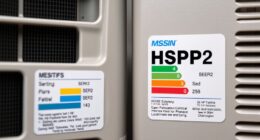To sanitize your countertop ice maker and remove slime without damage, start by unplugging it and emptying any water and ice. Use a mixture of vinegar and water or a manufacturer-approved sanitizer, applied gently with a soft cloth or brush. Let it sit briefly, then scrub away residue before rinsing thoroughly. Regular cleaning prevents slime buildup, and following safe techniques guarantees your unit stays in great shape. For detailed steps, keep exploring how to keep your ice maker fresh.
Key Takeaways
- Unplug the unit, remove existing ice, and empty water to start with a clean surface.
- Use a mixture of vinegar and water or a manufacturer-approved sanitizer to disinfect the ice mold gently.
- Apply the cleaning solution with a soft cloth or brush, avoiding abrasive tools that could damage surfaces.
- Rinse thoroughly with plain water to remove any residue, then dry completely to prevent future slime.
- Regularly clean and dry the ice mold, use filtered water, and avoid overfilling to prevent slime buildup.
Understanding the Causes of Slime Buildup in Your Ice Maker
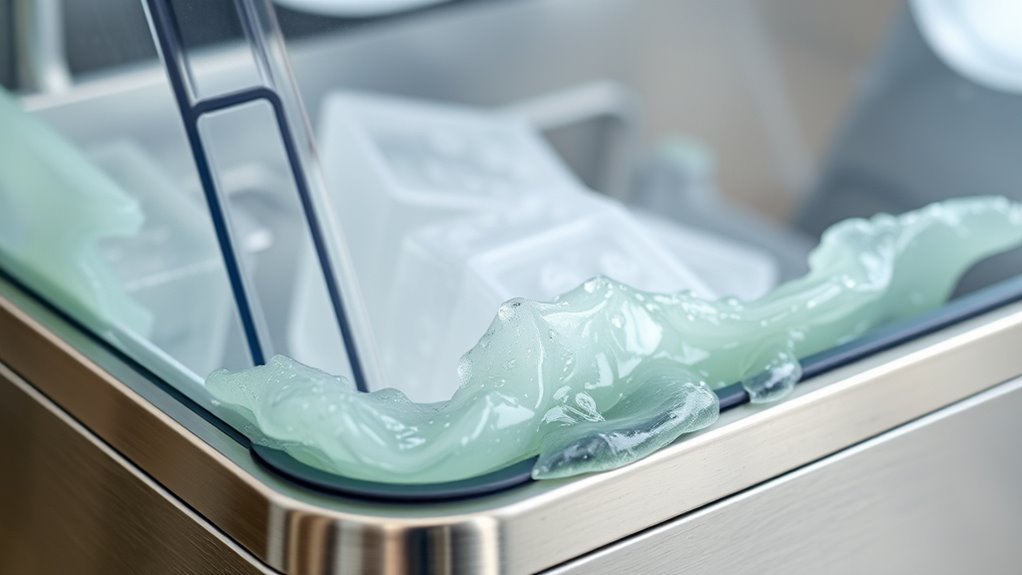
Slime buildup in your ice maker often results from a combination of moisture, bacteria, and mold thriving in damp environments. One key factor is the ice mold, which provides a perfect surface for bacteria to cling to if not cleaned regularly. Water quality also plays a role; minerals and impurities can encourage slime development and make cleaning more difficult. When water is stagnant or contains contaminants, bacteria and mold can grow unnoticed, especially in hard-to-reach areas like the ice mold. Over time, this buildup creates a slimy film that can affect ice quality and device performance. Using proper water filtration can help reduce mineral deposits and impurities that promote slime growth. Regularly inspecting your ice maker and ensuring good water quality helps prevent these issues and keeps your machine cleaner and safer.
Choosing Safe and Effective Cleaning Solutions
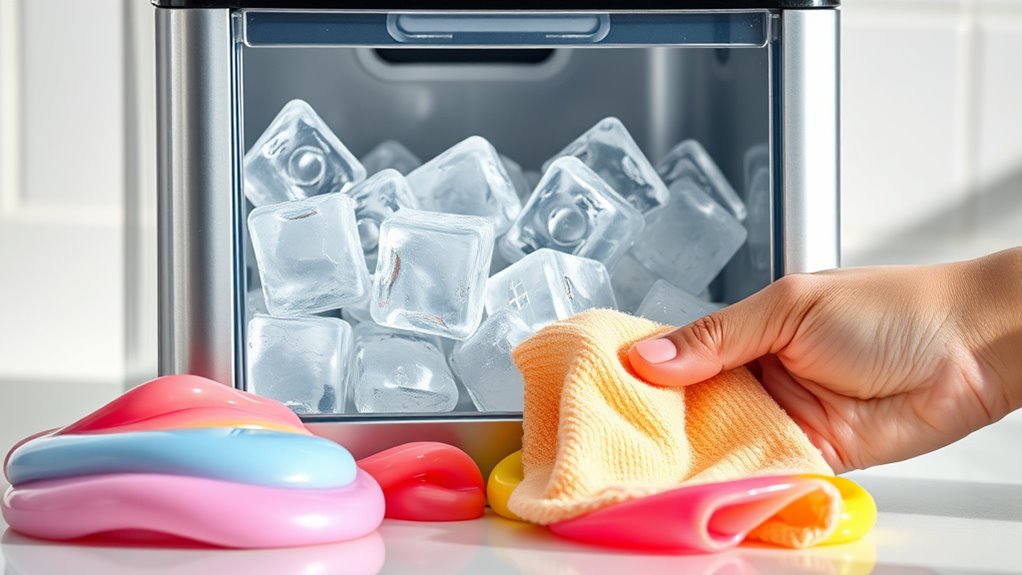
Keep these tips in mind:
- Opt for non-abrasive, food-safe cleaning agents
- Avoid bleach or ammonia-based products
- Use natural alternatives like vinegar or baking soda when appropriate
- Follow manufacturer recommendations for cleaning solutions
- Regularly inspect for slime buildup to adjust cleaning frequency
- Be aware that automation in business can influence maintenance routines and cleaning procedures, so stay informed on best practices.
Step-by-Step Guide to Sanitizing Your Ice Maker
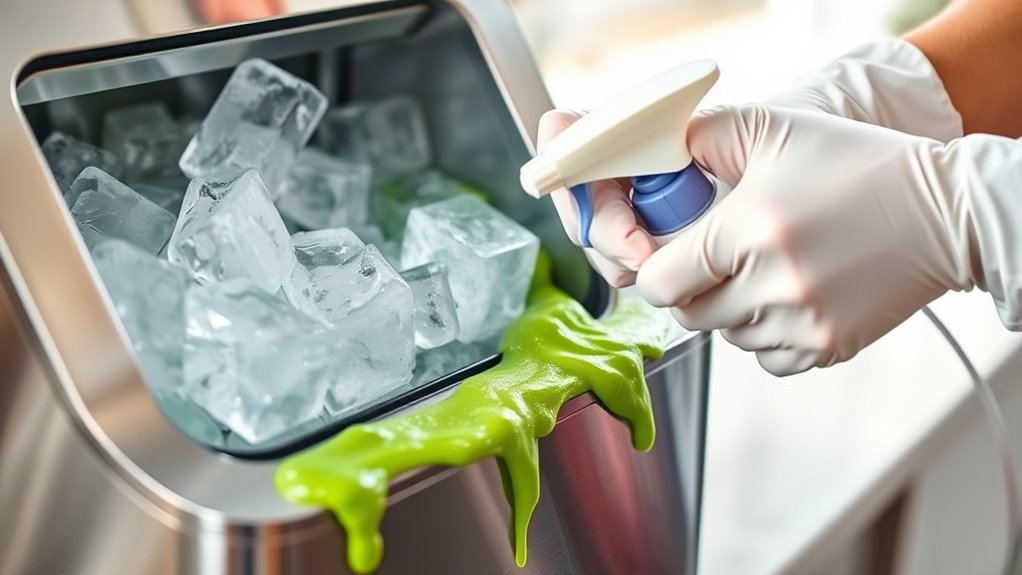
To effectively sanitize your ice maker, start by unplugging the appliance and removing any ice or water from the reservoir. This is a vital step in proper ice maker maintenance. Next, prepare a cleaning solution using a mixture of white vinegar and water or a manufacturer-recommended sanitizer. Pour the solution into the water reservoir and let it sit for about 10-15 minutes to loosen slime buildup. Then, use a soft cloth or brush to scrub away slime and residue, paying close attention to corners and crevices. Rinse thoroughly with clean water to remove all cleaning agents. Finally, wipe dry with a clean cloth and run a rinse cycle with plain water to guarantee no residue remains. Regularly performing these slime removal techniques keeps your ice maker clean and functioning properly. Being aware of industry trends can help you stay updated on the best cleaning practices for your appliance.
Tips for Preventing Future Slime Formation
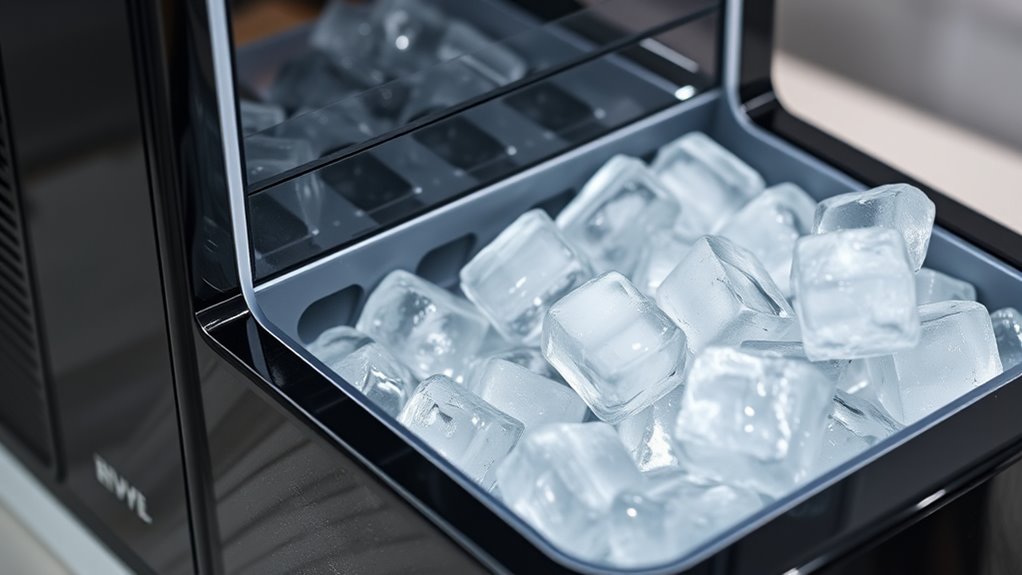
Regularly maintaining your ice maker not only guarantees it operates efficiently but also helps prevent slime buildup before it starts. To keep slime at bay, focus on these tips:
- Regularly clean the ice mold to remove residue and prevent slime growth
- Use filtered or purified water to improve water quality and reduce bacteria
- Empty and dry the ice mold after each use to prevent moisture accumulation
- Avoid overfilling the water reservoir, which can lead to stagnant water
- Schedule routine deep cleans to eliminate hidden slime-forming bacteria
- Ensure proper air circulation around your appliance to minimize moisture and mold development
Maintaining Your Ice Maker for Long-Term Freshness
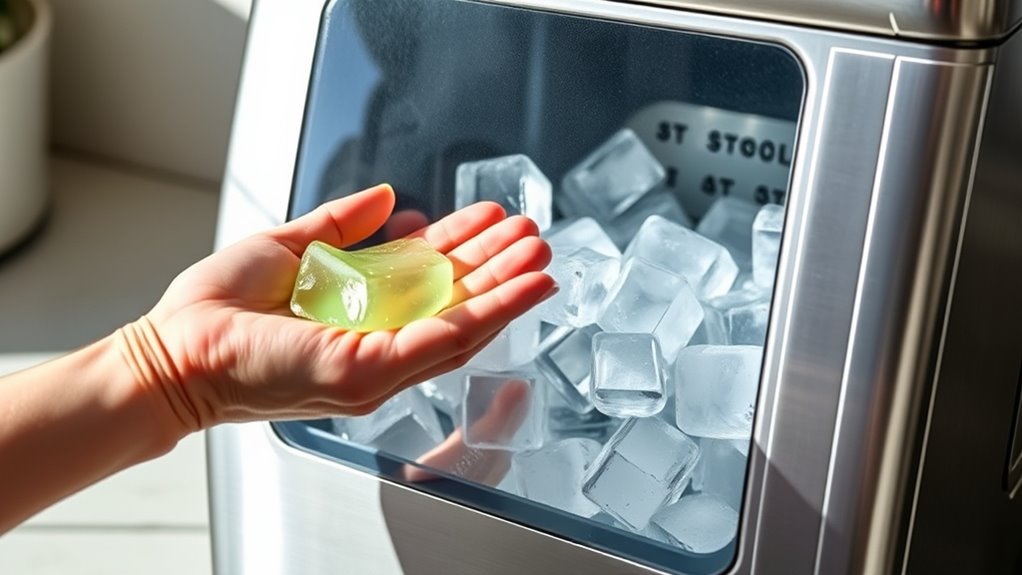
Maintaining your ice maker properly guarantees it stays fresh and functions efficiently over time. Regular ice maker maintenance is essential for slime prevention and keeps your appliance in top condition. Start by cleaning the interior and water reservoir weekly with a gentle sanitizer to prevent buildup. Always drain and dry the unit thoroughly after cleaning to avoid mold or slime growth. Check the filters and replace them as recommended by the manufacturer. Keep the ice bin dry when not in use, and avoid overfilling. Maintaining good hygiene reduces the risk of slime formation and extends your ice maker’s lifespan. Using appropriate cleaning products helps ensure your ice maker remains free of harmful residues and bacteria. Consistent upkeep ensures your ice stays clean and fresh, so you can enjoy cold drinks without worry. Proper maintenance is your best defense against slime and stale ice.
Frequently Asked Questions
How Often Should I Sanitize My Countertop Ice Maker?
You should disinfect your countertop ice maker at least once a month to prevent ice build-up and mold growth. Regular cleaning helps remove mineral deposits and bacteria, keeping your machine safe and efficient. After every few uses, wipe down the exterior and empty the water reservoir. If you notice any slime or mold, sanitize immediately. Proper maintenance ensures your ice maker stays in top condition without damage.
Can I Use Vinegar to Clean the Slime Safely?
Yes, you can use vinegar to clean slime safely, but guarantee proper vinegar safety by diluting it thoroughly. Vinegar is effective for slime removal, breaking down residue without damaging your ice maker. Always avoid using undiluted vinegar, as it might harm certain surfaces. Use a gentle scrub and rinse well to prevent lingering vinegar smell. With proper precautions, vinegar makes a natural, safe solution for cleaning slime from your countertop ice maker.
What Are Signs My Ice Maker Needs Cleaning?
You’ll know your ice maker needs cleaning if you notice ice buildup or water discoloration. Ice buildup can clog the system, reducing efficiency, while discolored water signals bacteria or mineral deposits. If your ice cubes look cloudy or taste off, it’s time to clean. Regular maintenance prevents slime and guarantees fresh, clean ice. Address these signs promptly to keep your ice maker functioning properly and your ice tasting great.
Are There Any DIY Natural Cleaning Alternatives?
Yes, you can use natural remedies and eco-friendly solutions to clean your ice maker. Mix equal parts white vinegar and water to disinfect and remove slime without damage. For added freshness, add a few drops of essential oil like lemon or tea tree. Run the mixture through the machine, then rinse with clean water. These natural alternatives effectively sanitize without harsh chemicals, keeping your ice maker clean and safe.
How Do I Prevent Slime From Returning After Cleaning?
Did you know that regular maintenance can reduce slime recurrence by up to 70%? To prevent slime from returning, focus on controlling ice buildup and ensuring proper water filtration. Clean your ice maker weekly, using natural disinfectants, and replace filters as recommended. Keep the area dry and wipe away excess moisture. This routine reduces bacteria growth, keeping slime at bay and maintaining a fresh, clean ice maker.
Conclusion
To keep your countertop ice maker clean, to prevent slime buildup, and to enjoy fresh, safe ice, you need to understand the causes, choose the right solutions, and follow proper cleaning steps. Regular maintenance and prevention are key to lasting cleanliness. By staying vigilant, staying consistent, and staying informed, you ensure your ice maker remains hygienic, efficient, and worry-free. Keep it clean, keep it safe, and keep enjoying icy refreshment anytime you want.
